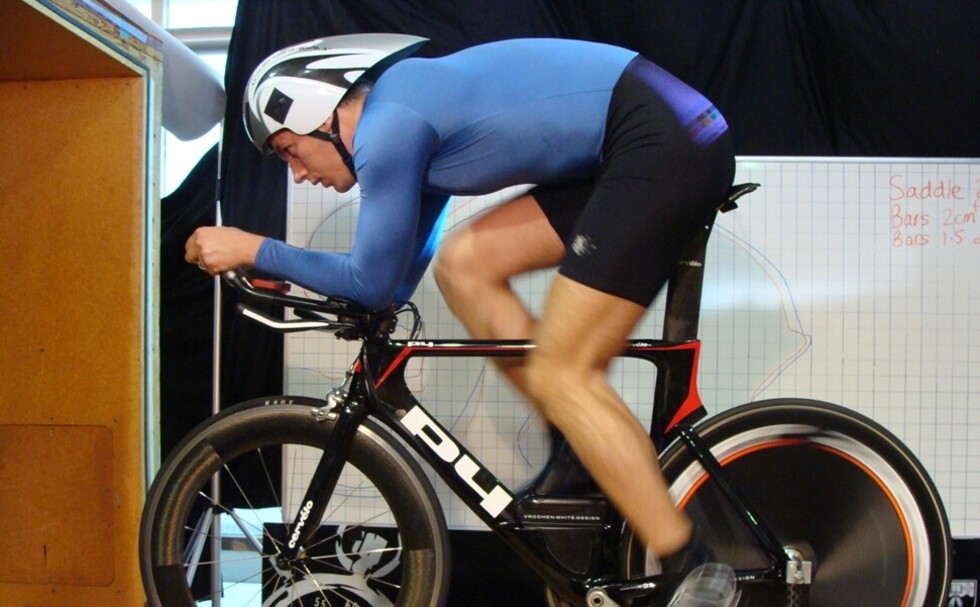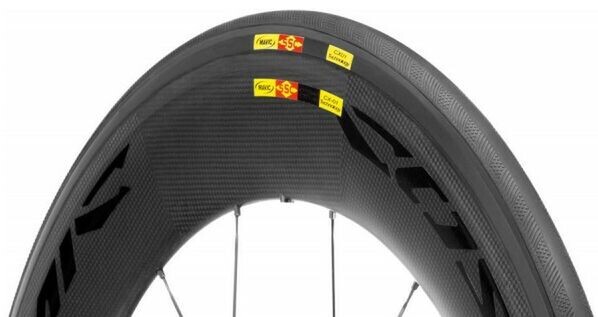Mavic have long lagged behind the rest of the wheel market on the aerodynamics front, instead coming out with rather dubious ”features” that created some of the slowest high end wheels around.
Some time in the last couple of years someone at Mavic had an epiphany… “our customers want fast wheels!!” (maybe they got tired of bikesnobnyc making fun of them)
Thus, they claim to have spent 400 hours in the wind tunnel in the past year. The new CXR80 wheel/tyre system is a product of this revised focus and has a lot of promising features.
As with most new wheel designs they’ve paid attention to the behaviour of both the trailing and leading edge of the wheel. As shown in this image (produced by Mavic and shown on bikerumour).
You will note that they’ve shaped the leading edge as a fairly traditional airfoil (corresponding to the NACA 0024 shape).
Whereas the rear takes a truncated form (in the style of Trek Speed Concept tubing) which is of course a necessity dictated by the tyre forming a blunt trailing edge (this shape follows NACA 0011).
The most attention grabbing aspect of the design is the clip on blades. The intent of the blades is to smooth the airflow around the tyre/rim junction. The picture to the right shows how the blades fill in that aerodynamically messy area (again produced by Mavic and shown on bikerumour).
This is well known as an area where speed can be gained, there is the old trick of filling that gap with silicon sealant, Bontrager produce tyres with a wing to smooth the transition to the rim and Hed extend the walls of their tubulars up the sidewall of the tyre a little.
It should be noted that the blades are currently banned by the UCI, so don’t get too excited about the idea if you road race/TT.
As with most new wheels they’re very wide – 28mm at widest and 27mm at the brake track, so clearance will be an issue on some bikes unless you shave down the brake pads.
In choosing their design parameters they did some good basic research – creating an on bike anemometer (wind meter) so they could determine the range of yaw that cyclists experience.
Overall I’m impressed by the process, they’ve done some good groundwork to base the designs on and they’ve taken a holistic approach to the wheel tyre system. There isn’t anything groundbreaking in the process (for instance – I did yaw distribution analysis and used 3d scans of a tyre to input to CFD in the aero design of carbon wheels 5 years ago and Zipp/Hed were well ahead of that) but there isn’t a lot of fresh ground left in this area.
I do have some reservations about their claims though. Obviously they’re claiming to have the ‘fastest wheels in the world’ which is par for the course with any new product release. However in this image (taken by a velonews journalist during the official presentation) they show some unusual behaviour for the Zipp 808:
The point at which the drag deflects (stops going downwards and starts heading up) is where the wheel is said to ‘stall‘ – the angle where the shape stops being so effective.
This chart shows the Zipp 808 stalling at 9 degrees. Zipps data shows this point to be just past 15 degrees and independent testing by TOUR Magazin (go to page 102 of this e-magazine) shows the same thing.
To highlight the discrepancy I have extracted the numbers from both graphs and can now present the curve that Tour shows for the 808 on the Mavic data.
Note that I’ve done this for demonstration purposes only – we can’t use different tests to properly compare equipment as there are too many sources of error. All I’m doing is showing the curve shape we expect from the 808.
For this comparison I anchored the 0 Degree result and, since the Tour test also measured in N, plugged in the differences from that start point. You can see fairly good agreement up to 9 Degrees (which suggests a reasonably valid comparison) and then the story changes dramatically. The black line of the Tour data continues to plunge where the Mavic data shows worsening performance.
What this suggests is that Mavic chose a tyre for the 808 that would hinder the 808s performance. I have data (that I can’t show) that demonstrates a 5 degree shift in stall angle for the 808 just from tyre choice and the Zipp curve above mimics one of the non-optimised patterns I’ve seen.
So Mavic throw the credibility of their data into doubt by trying to discredit one of the most tested (and therefore well understood) wheels on the market.
Additionally, the current Mavic Yksion tyres give away ~5w to some of the fast (but still reliable) tubular options. So unless the new CXR tyres have improved on the Yksions the performance of the wheel/tyre system may be less than the top competitors when we consider both aero and rolling resistance. And I’d also be interested to know whether the blades stiffen the sidewall of the tyre, thus increasing the rolling resistance.
I look forward to the first independent testing of the CXR80, I think the design and the process that led to it is promising, but I’d need to see other data before I added it to the list of wheels on my recommended list.

